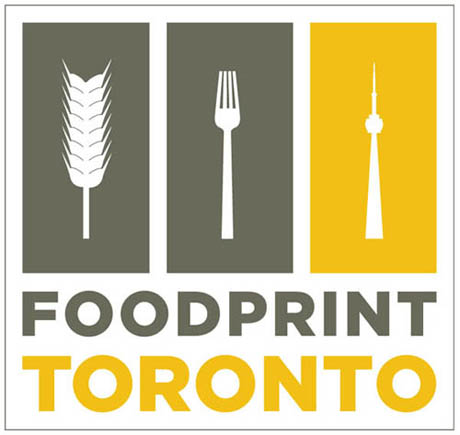
IMAGE: Foodprint Toronto (logo designed by the awesomely talented Nikki Hiatt).
The sharp-eyed among you — or at least the sharp-eyed among those of you who visit the site rather than reading through RSS — might have noticed the CN Tower has replaced the Empire State Building in the Foodprint logo. It’s true: Sarah Rich and I are very excited to announce that we’re hosting our next Foodprint Project event in Toronto on Saturday, July 31.
Foodprint Toronto is the second in a series of international conversations about food and the city. The first, held in New York City earlier this year, was a packed-out success, with a stellar line-up of speakers jumping to their feet to share their opinions on topics as diverse as food deserts and food printing, as well as tell fascinating stories about the role of protein in the city’s farmers’ markets and oysters in the city’s history. (You can still download videos of the event for free on iTunes U.)
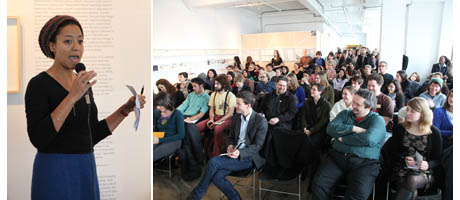
IMAGE: Makalé Faber Cullen addressing an overflowing Studio-X audience at Foodprint NYC. Photos by Ho Kyung Lee, Columbia GSAPP.
We’re hoping to replicate that energy in Toronto at the end of this month, and our timing means we’ll have a lot to discuss. In June alone, the Toronto Board of Health formally adopted a new city-wide food strategy and the Metcalf Foundation released its Food Solutions reports, filled with practical recommendations for fixing Toronto’s food system.
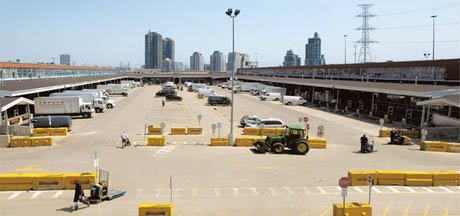
IMAGE: Every year, more than a million tonnes of produce travel through the Ontario Food Terminal, which has not shut down for a single day since it was opened in 1954.

IMAGE: A donut from Tim Hortons, the ubiquitous Canadian franchise. Photo by Jim Ross for The New York Times.
Meanwhile, Edible Geography’s Toronto-based friends, including Quiet Babylon and Infranet Lab, have recommended a range of reading material, speakers, sites, and themes. We’re researching everything from the Ontario Food Terminal (Toronto’s massive fruit and vegetable wholesale market) to the 7,000 working farms within Ontario’s newly protected Greenbelt, and drawing inspiration from Coach House Books‘ encyclopedic The Edible City: Toronto’s Food From Farm To Fork, and Alphabet City’s gorgeous Food volume.
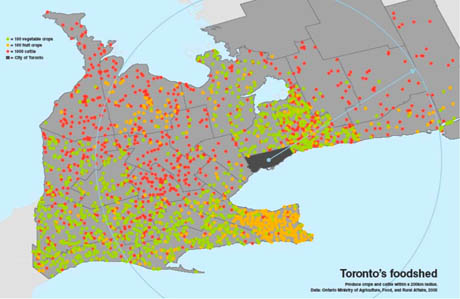
IMAGE: Nina-Marie Lister’s map of Toronto’s foodshed, showing cattle, vegetable crops, and fruit crops produced within a 200km radius of the city. In her essay, Placing Food, Lister notes that, “In 1960 most of Toronto’s food came from within 350 kilometres of the city, or almost entirely from within its foodshed. Today, at least 60 percent of the fresh produce consumed in Toronto is imported from the United States, a third of this arrives during Ontario’s growing season.”
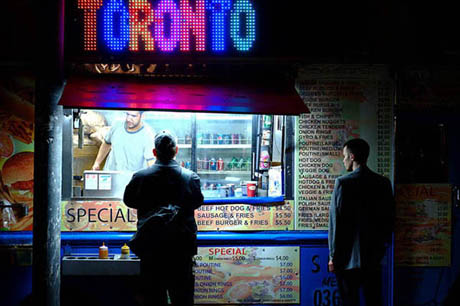
IMAGE: Until recently, Toronto city regulations restricted street food to “cooked meats,” which limited cart vendors and mobile snackers to a depressingly homogenous selection of hot dogs and kebabs.
Foodprint Toronto is curated into four separate panel discussions, over the course of which we’ll explore the forces that shape the city’s food and speculate on how to feed Toronto in the future. Given the quality and range of expertise in our list of confirmed panelists, I’m looking forward to an afternoon of conversations that encompass the impact of changing perceptions of “brain food” on Toronto’s school meals, the transportation challenges associated with maintaining urban food processing capacity, and the edible design potential of Toronto’s ravines, among many other topics!
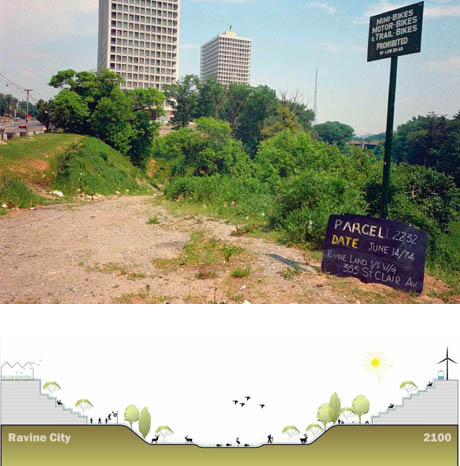
IMAGE: Architect and panelist Chris Hardwicke’s Ravine City proposal, “an urban ecosystem of collective housing that restores and enhances the ravine system of Toronto.”
And for those of you who endured the crush at Foodprint NYC: sorry, but we have learned our lesson, and secured a much bigger venue for Foodprint Toronto. We’ve been lucky to find a generous host in Artscape Wychwood Barns (map), an amazing regeneration project that transformed Toronto Transit Commission’s disused streetcar repair facilities into a community centre, complete with artists’ live/work studios, rehearsal and event space, and The Stop Community Food Centre’s Green Barn: a year-round temperate greenhouse, sustainable food education centre, sheltered garden, outdoor bake oven, and compost demonstration site.
More details follow below, but to stay up-to-date as we share research, confirm speakers, and add program elements, please join the Foodprint Project mailing list and follow us on Twitter. If you have ideas, suggestions, questions, or offers of sponsorship (food, beverages, and videography would be particularly welcome), feel free to leave a comment or email me directly — I’d love to hear from you. You can also download our press release here.

IMAGE: Toronto’s Victory Gardens. In Lorraine Johnson’s essay, Revisiting Victory: Gardens Past, Gardens Future, she writes that, “Five out of every ten urban households surveyed in 1943 planned to have a Victory Garden. […] The Torontonians of 1943 responded to the call to grow food, to become ‘a city of community gardens,’ not only because it was the right thing to do in a time of war, but because the City enacted policies that turned it into an easily possible thing to do.”
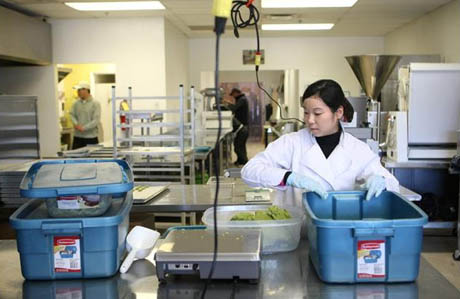
IMAGE: Susan Ho’s company, Tea Aura Inc., developed its tea-infused cookie business at the Toronto Food Business Incubator, a city initiative run by Foodprint Toronto panelist Michael Wolfson. Photo by Brett Gundlock/National Post.
Date: Saturday, July 31
Time: 12:30 p.m. to 5:00 p.m.
Location: Artscape Wychwood Barns (map)
Program Schedule:
12:30 – 1:30: Zoning Diet | How do zoning, policy, and economics shape Toronto’s food systems?
1:30 – 2:30: Culinary Cartography | What can we learn when we map Toronto using food as the metric?
3:00 – 4:00: Edible Archaeology | How has today’s food culture in Toronto been shaped by social changes, economic fluctuations, and technological innovations throughout the city’s history?
4:00 – 5:00: Feast, Famine, and Other Scenarios | What are the opportunities and challenges of Toronto’s possible food futures?
Panelists include:
• Natasha & Andrew Akiwenze, Akiwenzie’s Fish
• Barbara Emanuel, Senior Policy Advisor, Toronto Board of Health, City of Toronto, and co-author, Cultivating Food Connections
• Mark Fram, architectural consultant, designer, and urban planner
• Chris Hardwicke, Associate, Sweeny Sterling Finlayson & Co Architects, and designer, Farm City, Ravine City, and Velo-City
• John Knechtel, Director, Alphabet City Media
• Shawn Micallef, Senior Editor, Spacing magazine, and author, Stroll
• Darren O’Donnell, Artistic Director, Mammalian Diving Reflex
• Rebecca O’Neill, Department of History, University of Toronto
• Kathryn Scharf, Program Director, The Stop Community Food Centre, and co-author, Metcalf Food Solutions Report, In Every Community A Place For Food
• Lola Sheppard, Principal, Lateral Architecture, Director, InfraNet Lab, and Assistant Professor, University of Waterloo
• Jessica Duffin Wolfe, Arts and Books Editor, Spacing magazine
• Michael Wolfson, Food & Beverage Cluster Specialist, City of Toronto
• Robert Wright, Associate Professor, John H. Daniels Faculty of Architecture, Landscape, and Design, University of Toronto
[NOTE: A huge thanks to our numerous behind-the-scenes advisors and helpers, including Tim Maly, Mason White and Lola Sheppard, Andrew Blum, Leslie McBeth, Valentine Cadieux, Laura Taylor, Rebecca Federman, Geoff Manaugh, and Alexis Madrigal, who deserves a medal for his heroic work on our lovely new website.]

